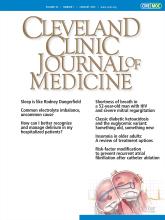Symptoms to Diagnosis
Shortness of breath in a 52-year-old man with HIV and severe mitral regurgitation
Felix Wangmang, MD, PharmD, Achilles Aiken, MD and Kuang-Yuh Chyu, MD, PhD
Cleveland Clinic Journal of Medicine January 2025, 92 (1) 23-30; DOI: https://doi.org/10.3949/ccjm.92a.24060
Felix Wangmang
Department of Medicine, Cedars-Sinai Medical Center, Los Angeles, CA
Achilles Aiken
Department of Cardiology, Smidt Heart Institute, Cedars-Sinai Medical Center, Los Angeles, CA
Kuang-Yuh Chyu
Professor, Department of Cardiology, Smidt Heart Institute, Cedars-Sinai Medical Center, Los Angeles, CA
In this issue
Cleveland Clinic Journal of Medicine
Vol. 92, Issue 1
1 Jan 2025
Shortness of breath in a 52-year-old man with HIV and severe mitral regurgitation
Felix Wangmang, Achilles Aiken, Kuang-Yuh Chyu
Cleveland Clinic Journal of Medicine Jan 2025, 92 (1) 23-30; DOI: 10.3949/ccjm.92a.24060
Jump to section
- Article
- EVALUATION ON ADMISSION
- DIFFERENTIAL DIAGNOSIS
- CASE CONTINUED: TRANSTHORACIC ECHOCARDIOGRAPHY
- CAUSES OF PULMONARY HYPERTENSION
- DIAGNOSING PULMONARY HYPERTENSION
- CASE CONTINUED: RIGHT HEART CATHETERIZATION
- MITRAL REGURGITATION TREATMENT OPTIONS
- CASE DISCUSSION
- CASE CONCLUSION
- TAKE-HOME POINTS
- DISCLOSURES
- REFERENCES
- Figures & Data
- Info & Metrics
Related Articles
- No related articles found.
Cited By...
- No citing articles found.






